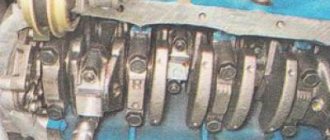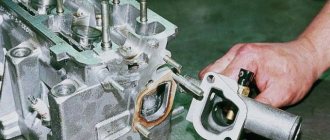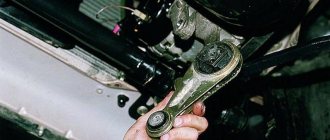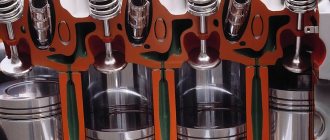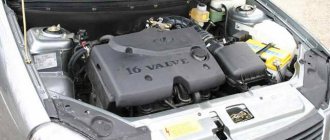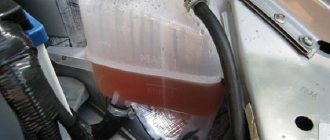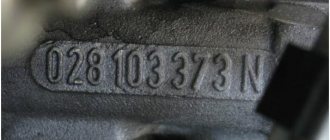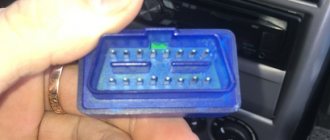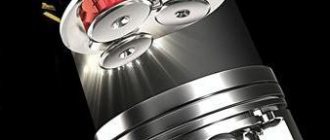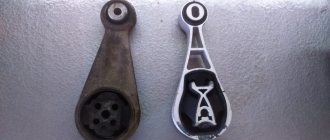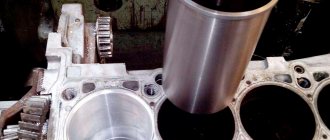When overhauling an engine, the main components of the power plant are subject to deep restoration or change. The process allows you to return the motor to factory performance characteristics. Engine repair involves restoring the entire power plant, and not just some components. The procedure is quite expensive and must be performed using specialized equipment by qualified craftsmen.
see also
Comments 44
What kind of piston was installed, whose production? Name?
Hello, I’m installing the piston 126th 82.5, I want to assemble it on the Prior’s cylinder head gasket, won’t the valve bend if the belt breaks?
Having become the piston recesses and becoming a metal package gasket. Everything will be fine
I had a Priora 222000, but 3 days ago a problem happened at 155 speed, either a piston pin or a piston broke, the head was removed, there was a bare connecting rod in the 3rd cylinder, the piston was in the trash, and there was a hole in the block opposite the 4th
Such a question: Priora car, Connecting rods 124 After a thorough overhaul, 20 tons went through. Ditonation began after 6 tons. Oil changed every 5 tons. Mobile oil 10 to 40. At 20 tons. I drove from the countryside and pressed decently. And at that moment the traction disappeared, the revolutions began to drop, from the rear. smoke screen. The temperature was normal. I stopped, opened the hood, oil squeezed out from the dipstick, the car was shaking and stalling. Somehow I got home at 40 kph and it didn’t flare up anymore. At home I unscrewed the spark plugs. In cylinder 2 there is a spark plug in metal shavings. What is the reason? How much will the repair cost? By the way, this happened after refueling 30 km. After refueling, a ringing sound appeared after 4 tons of revolutions. Maybe the fuel is not of good quality?
Hi all! Tell me, I want to make capital, 126 engine. Which pistons are better to choose with which group? What does Stoda need for the piston group? Some people are talking about ten pistons, others about Priora FM pistons. If you set the decimals, then do you need to change the connecting rods? I also don’t want to overpay... What pistons can be installed on the original connecting rods? Please advise something, dear prior leaders. This is the first time I’ve encountered such a problem, simply as a major overhaul... Thanks in advance.
Install black edition
Hi all! Tell me, I want to make capital, 126 engine. Which pistons are better to choose with which group? What does Stoda need for the piston group? Some people are talking about ten pistons, others about Priora FM pistons. If you set the decimals, then do you need to change the connecting rods? I also don’t want to overpay... What pistons can be installed on the original connecting rods? Please advise something, dear prior leaders. This is the first time I’ve encountered such a problem, simply as a major overhaul... Thanks in advance.
If you don’t want to change the connecting rods, then if you became a 10 piston, I would install Priorov’s ones, I would already install STK dick expert super piston
Hi all! Tell me, I want to make capital, 126 engine. Which pistons are better to choose with which group? What does Stoda need for the piston group? Some people are talking about ten pistons, others about Priora FM pistons. If you set the decimals, then do you need to change the connecting rods? I also don’t want to overpay... What pistons can be installed on the original connecting rods? Please advise something, dear prior leaders. This is the first time I’ve encountered such a problem, simply as a major overhaul... Thanks in advance.
Now I’m assembling an engine also using Kostroma pistons on my Priora. Do you remember how many hundred parts were made for the thermal gap of the piston-cylinder?
honestly - I don't remember
Now I’m assembling an engine also using Kostroma pistons on my Priora. Do you remember how many hundred parts were made for the thermal gap of the piston-cylinder?
and where is the manufacturer’s description of the spare parts you took?
Greetings! How are things going with the engine at the moment? Did you remove the block to bore it? I'm also going to invest
I sold the car to a friend and he is tearing it up in its tail and mane. Doesn't eat oil, pistons don't rattle. after capitalization the car has already run more than 80k
The pistons also started knocking at 120 thousand, we changed the pistons, the knocking went away, but the oil began to burn. Now it’s 160 thousand and the pistons are knocking again... I’ve been thinking for a long time whether to set it to 124 or to risk sticking it in at 126 again. I decided to put 124, because... the master seems to have been caught with a ball and says that it will work even better, but there are tricks) In general, they installed 124, punched the catalyst, reflashed and voila))) It’s tearing right away, I’ll say it’s better than on 126, in my opinion, acceleration has become more dynamic and easier, zhor oil is gone. And most importantly, for a long time. So if you just set it, it will be a little worse to drive than 126, but for anyone, someone won’t even notice. You punch the catalytic converter and flash it and it goes better) and most importantly for a long time! I am surprised at our manufacturers, it seems that garage craftsmen are much more competent than these VAZ engineers who make engines up to 100 thousand. Yes, the new Priora drives briskly, but not for long!)))) Fortunately, spare parts and repairs are cheap.
It seems to me that there are 124 pistons, I bought the car after a major overhaul, everything was replaced, the piston connecting rods, etc. the question is, if there are 124 pistons, what kind of gasoline can be poured in? AI92
AI 95 is everywhere. Although you can flash the ecu for 124 shg, for driving on AI92.
I found out that they supplied me with lightweight plugless pistons with a displacement combustion chamber
Repairing engine 21126 VAZ 2170 Priora after timing belt break
Today we brought one of the old clients to the Priora, as it turned out, the jammed pump broke the belt and, as a result, the valves were bent.
But progress at AvtoVAZ does not stand still, and if on the engines of the tenth family the valves were simply bent, then on the Priora 126s the connecting rods also lose alignment and, if they are not changed, there is a high probability that the engine will begin to eat oil and, accordingly, your money. Glory to the designers of AvtoVAZ!
But every cloud has a silver lining, there are sets of pistons for 126 engines with grooves that do not bend the valves. In this article we will describe the procedure for repairing the cylinder head after a broken timing belt, as well as replacing the piston. Removing and installing the timing belt is described in this article, so we will not dwell on it in detail.
What is needed for a major overhaul
When performing engine overhauls, attention must be paid to each engine component. To do this you will need a whole list of spare parts:
The list of spare parts may be expanded or shortened. This depends on the amount of work being done, the complexity of the engine repair, and the need to replace a specific spare part. In certain situations, you can avoid repairing a specific unit due to the excellent quality of the parts. It all depends on the degree of wear. This will all tell you what equipment you need to use in your work.
It is impossible to talk about the specific cost of the spare part. It will vary depending on the manufacturer, supplier and distributor. In addition, prices fluctuate depending on the market rate. For foreign cars, it is best to purchase used spare parts that will be of decent quality. The price will be almost halved.
It is worth paying attention that when carrying out repairs at a service station, craftsmen can recommend their own spare parts for installation, having their own supply network, offering a complete list. This will avoid expenses in case of necessary refurbishment. But the cost of spare parts will be slightly higher than on the market. If you purchase them yourself, there will be cases of waiting for delivery. This will also lead to payment for storing the car at the service station.
Important! Before purchasing any spare part for major repairs, you should consult with a specialist who will carry out the repair work. Since he encounters this every day, he will be able to suggest what and how best to choose. This will help avoid overfitting.
Let's start to disassemble
First, drain the oil and antifreeze. We remove the protective cover, the air filter with pipes, disconnect the ignition coil connectors, the throttle cable and the throttle assembly.
We remove the thermostat housing and simultaneously disconnect all the available connectors and pipes. We remove all the wiring that was in our way towards the battery.
We remove the generator. We unscrew the eight thirteen nuts holding the intake manifold and remove it. We unscrew all the bolts securing the valve cover, as well as the side engine support.
Unscrew the eight nuts and remove the exhaust manifold.
Remove the timing belt, camshaft pulleys and pump.
In three passes, so as not to deform the part, we first loosen and then unscrew twenty bolts of the camshaft bearing housing, the head is eight. Be sure to follow the sequence shown in the photo.
Remove the bearing housing. We remove the camshafts; there is a distinctive lip on the intake camshaft.
Also, in several passes, we first loosen and then unscrew the ten cylinder head mounting bolts. Be sure to follow the sequence shown in the photo.
Remove the cylinder head. All sixteen valves are replaced.
Required Tools
Repair work requires a set of certain tools - this can simplify and speed up the process.
To repair the engine and valves, you need the following tools:
- Set of keys.
- Screwdrivers.
- Valve spring extractor.
- Pullers for valve stem seals.
- Tweezers.
- New valves.
- Cylinder head gaskets.
An important point: valves can only be purchased as a set. There is no point in removing and installing only one valve, because soon the other valves will also break.
Cylinder head repair
We mark all hydraulic compensators with numbers using an ordinary clerical touch and put them away. An ordinary magnet will help you pull them out. We dry out the valves and remove the oil seals (valve seals), the valves into scrap metal, the oil seals into the trash. We clean all channels. We take the head for grinding, just in case. After washing it again with kerosene after sanding and blowing it with air, we begin to assemble it.
We arrange the freshly purchased valves in the sequence in which they will stand in the cylinder head and begin to grind in one by one. Lubricate the valve stem with clean oil and apply lapping paste to the edge.
We insert the valve into place and put a valve grinding tool on the valve stem. The stores sell a device for manual lapping, but since this is the twenty-first century, we are mechanizing the process. We take the old valve and cut off the rod from it, select a rubber tube for it of such a diameter that it fits tightly. The rod is in a reversible drill, one end of the tube is on it, the other is on the valve being ground in. At low speeds we begin to grind the valve, constantly change the direction of rotation and periodically press it to the seat or weaken the force. On average, the valve takes about twenty seconds. We take it out and wipe it. The valve is considered ground in if a uniform gray strip of at least 1.5 mm wide appears on the chamfer.
The same stripe should appear on the valve seat.
Video of manually grinding valves
For a sixteen valve head, everything is the same, only there are twice as many valves.
After lapping, all valves and seats are thoroughly wiped and washed with kerosene to remove any remaining lapping paste. We check for leaks. We tighten the old spark plugs and put all the valves in place. Pour kerosene and wait three minutes, if the kerosene does not run away all is well, otherwise we grind the valves on this cylinder.
We had to grind four valves again, after which the kerosene stopped flowing.
We stuff new valve seals.
We put the valves in place and dry them. Before doing this, lubricate the valve stems with clean oil. After lubricating it with clean oil, we put the hydraulic compensators in place and, covering them with a clean cloth, remove the head out of sight. We're done with the cylinder head.
When is it time to change?
When operating the car, you should constantly ensure that the cylinder head is sealed against the block itself so that there are no leaks of working fluids. Like all car components, the cylinder head requires regular maintenance. Parts that are under constant load require more attention. These include components of the gas distribution mechanism: valve seals, valves, camshaft seals, gasket. The service life of its components and assemblies depends on the quality of car maintenance.
Cylinder head repair
Replacement of consumables should be carried out according to the recommendations specified in the Lada Priora service manual. Oil seals and gaskets should be replaced as they wear out or if they are externally damaged. There are a number of operations that require dismantling the cylinder head: modification and grinding of seats, replacement of valves, crimping of valve seats and bushings, and others.
The cylinder head on a Lada Priora 16 cylinders must be replaced if chips, cracks, and signs of corrosion are detected during its visual inspection. During repairs, the following work can be performed:
- change gaskets;
- camshafts are being replaced;
- change hydraulic compensators if they are faulty;
- change bent valves if the timing belt breaks.
Let's move on to the cylinder block
We remove the pallet. Rotating the crankshaft as it is convenient for us, unscrew two bolts on each connecting rod cap. We use a TORX E10 head for this.
We take out the pistons along with the connecting rods. To do this, use the wooden handle of a hammer to press the connecting rod from below and lightly tap it to knock it up. We remove the old liners and buy new ones of the same size according to the markings on them. Here is another stone in AvtoVAZ’s garden, the owner has never climbed into the car from the interior or into the engine, but three pistons were of group “B” and one was “C”. It turns out that at the factory they re-sharpened one cylinder a little and simply put an enlarged piston there, no words. There are no options, we take group “C”, don’t sharpen the engine because of this. We will not touch the main liners either.
We buy a new piston group that does not bend the valves, connecting rods and connecting rod bearings.
Eliminating longitudinal play of the crankshaft
It was noticed on this motor. To eliminate it, replace the thrust half-rings. Standard and repair sizes are available. We take the first repair size, if they are too tight we sand them down a little. We unscrew the middle main bearing and gently push it with a screwdriver and move the half rings. The mark on it is in the form of three serifs, shown below.
When the half ring comes out a little, turn the crankshaft, it will push it out. There are two types of half rings: white at the front and yellow at the rear; the grooves on them should point towards the crankshaft cheeks.
We install them as we removed the new half rings; if they go in with great effort, you can grind them a little on a small abrasive stone, but not from the side of the grooves. Checking the play. We tighten the main bearing with a torque of 8 kgf*m.
Assembling the piston
There is an arrow stamped on the top of the piston; it should be directed towards the front of the engine. And there are marks on the connecting rod that should look the same way. Don't get confused!
We insert one retaining ring into the groove on the piston. We insert the connecting rod into the piston and, having lubricated the connecting rod and the piston pin with oil, insert it into place. Insert the second retaining ring. Although this operation seems simple, it will take some pains. We inspect the assembled structure; all retaining rings must be clearly in their grooves, otherwise a ring that has jumped out while the engine is running can cause a lot of trouble.
After assembly, you need to break off the connecting rod bearing cap, since the connecting rod is made in one piece. It's like that on our cars. First, unscrew the bolts. We insert the connecting rod into the cleats at the level of the mark shown in the figure with the black arrow and lightly clamp it, then break it off with a slight movement of the hand. The first time is very scary. We put the cover in place and tighten the bolts so as not to mix it up in the future.
Checking the thermal gap in the piston rings
We lay out each set of rings for each cylinder. In the future we will not change their places. In turn, we insert each ring into its own cylinder and push it a little with the piston approximately to the middle.
We measure the gap with feeler gauges.
Nominal clearance: 0.25 - 0.45 mm.
The maximum clearance for all is 1 mm. But this already smacks of waste.
Installing new rings
First, install the oil scraper ring expansion spring, then the ring itself. The oil scraper ring lock should face the opposite direction of the spring lock. Then we install the lower compression ring and finally the upper compression ring. The inscription “TOP” must be stamped on the rings; it must face up. The rings in the piston grooves must rotate easily.
Camshaft marks
The VAZ 21126 engine uses two switchgears. One of them is needed for optimal operation of the intake valves, and the second is installed in order to regulate the movement of the exhaust valves.
Each camshaft has its own pulley, which is not recommended to be replaced with another. This pulley allows the camshaft mechanism to operate correctly. A phase sensor is installed on the right side of the pulley.
The marks are located on the pulleys. They are located on the crown of the ledge at the bottom. Experienced mechanics call them movable because they move with the rotation of the camshaft.
Attention! Beginning car owners should remember that the marks have different sizes. It all depends on the manufacturer who made the pulley.
To see the marks, experienced mechanics advise wiping the pulley with a clean rag to get rid of dirt and dust. Then you will notice a small notch in the metal.
But the crankshaft marks will help all parts of the 126 engine from the Lada vehicle work equally. At the output of the crankshaft there is a gear. And this gear is connected to the device by means of a key. This is where the mark for correct installation of parts is located. Because if the position is incorrect, the key simply will not fit as expected.
The notch is made in the form of a slot or a conical hole. It is found on the outside of the engine pulley.
Additional guidelines are also applied to the outer engine housing so as not to make mistakes when setting marks. To do this, install another mark on the rear side of the timing belt housing. It is needed for the correct alignment of the camshaft pulleys.
Another notch is located on the engine oil pump. It is needed for the correct orientation of the crankshaft. And it will be difficult to find the last mark. It is located on the flywheel.
There is a small cutout in the flywheel housing. According to the standard, it is covered with a rubber plug. It is pulled out and inserted with pliers.
Engine assembly
We wipe the crankshaft journals, cylinder bores and connecting rod bearing seats with a clean rag; by the way, they can also be degreased. We put new liners into the connecting rod and the cover, so that the antennae of the liners fit into the grooves.
Lubricate the bearings, crankshaft journals and cylinders with clean oil. We unfold the piston rings with locks as shown in the figure, the angle between them should be 120 degrees.
We put a mandrel on the piston to compress the rings, having previously lubricated it inside with clean oil. Not forgetting about the direction, the arrow on the piston should be directed towards the front of the engine, we place it in its cylinder.
We turn the crankshaft so that the connecting rod journal is at the very bottom. Gently tapping the wooden handle of a hammer pushes the piston into the cylinder. We remove the mandrel and push the piston down until the connecting rod sits on the crankshaft. We put the connecting rod bearing cap on the bottom, remembering the marks. Tighten the connecting rod cover mounting bolts to a torque of 5 kgf*m. We also repeat with all the other cylinders.
We put back everything that we removed from below. We blow through the top and clean the holes for the cylinder head mounting bolts. We install a new cylinder head gasket and the head itself. Lubricate the bolts with a thin layer of oil, most importantly without fanaticism. We tighten the bolts in several passes in the reverse order of unscrewing, see photo at the beginning of the article. The tightening sequence is as follows:
- first tighten everything with a torque of 2 kgf*m
- then we tighten everything to a torque of 7 – 8 kgf*m
- turn it 90 degrees
- turn it 90 degrees again
We install hydraulic compensators, camshafts and camshaft bearing caps. Lubricate all rubbing surfaces with clean oil. Before installing the camshaft bearing caps, lubricate the perimeter and rims around the spark plug wells with a thin layer of sealant. We tighten the bearing cover bolts in the reverse order of unwinding, with a torque of 2 kgf*m, see photo at the beginning. Well, then we install all the parts in the reverse order of removal. We fill in all the fluids and start it, it may not start right away, this is normal. When you first start it will smoke well until the oil on the cylinders burns, make sure the oil pressure light goes out. Let it run for a minute and turn it off, and suddenly see where something is leaking. We start it several more times, constantly increasing the operating interval, bring it to operating temperature, constantly checking the oil and antifreeze, and also pay attention to the fact that no extraneous noise appears. Let it rest for an hour and then idle again for about an hour, constantly monitoring the temperature. Well, then the break-in, if you sharpened it, if not, then you can drive only the first thousand kilometers, try not to raise the speed above 3000, and not tow it.
Motor 126 and 127: working life, differences
These engines on Priora had a displacement of 1.6 liters (or 1596 cm3). Optimal for city sedans, the engine size of the Lada Priora gave a good combination of dynamics and consumption: along with very decent acceleration, fuel consumption does not exceed sky-high numbers. Both engines received good marks, because the car behaved perfectly in the city and on the highway.
In fact, the 126 Priora engine became the first sixteen-valve engine for this model, and the 127 is a modified version, “overclocked” by AvtoVAZ designers. In addition to the same engine displacement, they have other identical characteristics. The in-line type of arrangement of four cylinders provides a simplified design that can be repaired on your own.
The distributed multipoint injection system is involved in creating a good, rich fuel-air mixture (a lean mixture can lead to breakdowns). The cylinder diameter is 82 mm, the piston stroke is 75.6 mm, the compression ratio is 11. The “engines” fall under the Euro 4 standard, they are powered by gasoline with an octane rating of 95.
The 126 engine for the Priora received the following characteristics: 98 hp. (72 kW at 5600 rpm), acceleration to 100 km/h in 11.5 seconds (with manual transmission), city consumption 9.1 l - 100 km (manual transmission), maximum torque - 145 Nm.
The 127 engine for the Priora was upgraded to the following figures: 106 hp. (78 kW at 5800 rpm), acceleration to 100 km/h in 11.5 seconds (with manual transmission), city consumption 8.9 liters per 100 km (with manual transmission), maximum torque – 148 Nm.
The difference may not seem so noticeable, but this is a very small but strong step in design on the part of AvtoVAZ (this is where the change to sixteen-valve “engines” with a volume of 1.6 liters ended). For a car of the Lada Priora class, the engine power was sufficient.
In the same block it is necessary to say about the operating temperature. An absolutely normal operating temperature is considered to be between 90 and 95 degrees Celsius. Further, when the car is being pushed in a traffic jam, is basking in the sun, or for some other reason, but can still work - from 97 to 110 degrees. The engine is slow in places and wears out a lot, but you can still get to your destination. A temperature below 90 degrees is a direct sign indicating that the car has not yet warmed up, and it is better to wait in place until the arrow points to the coveted 80-90 mark.
Operating a car at temperatures above 110 degrees is dangerous because the service life of the engine is noticeably reduced - hot parts undergo very severe wear, overcoming the force of friction.
In general, the service life of the Lada Priora engine with a normal driving style and careful treatment is 200,000 km - after this mark the time comes when the “engine” requires major repairs. AvtoVAZ mentioned the timing belt separately as a recommendation, saying that it needs to be checked every 100,000 km (many car enthusiasts talk about the figure of 50,000 km).
All Lada engines have a problem, and it is related to the valves, which will be discussed further.
A short summary
Reasons for the need for a major overhaul of the Lada Priora engine
The main reason for starting a major overhaul of the Priora engine, be it the 16-valve VAZ 21126 and VAZ 21170 or the 8-valve VAZ 21116 engine, is the “oil burner” of the engine. The reason does not always lie in scuffing the walls of the cylinder block or damage to the pistons; often, to the delight of the car owner, the reason for the engine consuming oil is the occurrence or coking and sticking of oil rings, as well as wear of the oil seals on the valves. Such repairs will cost much less than a complete overhaul of the Priora engine with boring, replacing the piston group with a repair one and installing it on the crankshaft.
In fact, this is far from a complete list of reasons for increased engine oil consumption. In the article about the reasons for high engine oil consumption, we provided a table with a list of reasons that may cause increased engine oil consumption, as well as a table with data on oil consumption rates for various engines. Not every reason for oil loss will lead to a major overhaul of the Lada Priora engine; many reasons can be eliminated by simply replacing the element through which the engine passes oil, for example a camshaft oil seal or one of the crankshaft oil seals, a cylinder head gasket, or a damaged oil filter.
How much does engine 126 and 127 cost?
Engine 126 has catalog number 21126100026030, sells for about 107,000 rubles, engine 127, respectively, has catalog number 21127100026030, its price is slightly higher by 3-5 thousand rubles. The price on the secondary market will be significantly lower (up to 20-25 thousand rubles), but the savings will not pay off - a used “engine” can last no more than 1000 km, this is a real lottery.
How to find out what engine is in a Priora
You can find out by looking at the plate on the left glass of the rack, where the engine number is written on the edge. From it you can understand the 8-valve unit, or 16. You can also recognize the modification 21126 or 21127.
Signs of the need for internal combustion engine repair
The reasons why the operation of the engine is disrupted are arranged in a small list, starting with refusal to start and ending with floating idle speed (this problem was removed on the 127 “engine”). Not all breakdowns end in capital damage - sometimes it’s enough to add oil, sometimes it’s enough to adjust the ECU settings.
Compression reduction
A decrease in cylinder compression below 16 atmospheres is a bad sign. Such a high limit corresponds to a compression ratio of 11.
If the compression decreases (or vice versa increases), then the “engine” will have to be rebuilt.
Knocks in the engine
Engine knocks can come from several points. These could be hydraulic compressors, timing belt rollers or pins. The knocking noise could also be caused by low oil level. The answer to the question will be given by a thorough detailed inspection of all parts of the unit and checking the oil level.
Blue smoke from the exhaust pipe
The blue smoke that comes from the exhaust pipe appears when oil enters the combustion chamber. It can leak either from the valves or from under the piston. The result is the same: the oil is eaten up and blue smoke pours out of the chimney. Once the leak is located, half the problem will already be solved.
Troit motor
Sometimes in the cold the engine may stall - don’t be alarmed by this, because it may simply be one of the spark plugs that fails. In this case, we advise you to simply restart the engine and it will stop running.
How to remove the receiver on a Priora
Tools that may come in handy: - 10mm socket; - key 13; - screwdriver.
To remove the intake manifold you will need:
- Due to the fact that in the next steps of the instructions there will be manipulations with electrical wiring, it is necessary to remove the negative terminal of the battery.
- The next step is to remove the plastic screen (cover) from the engine housing. This is done so that it does not interfere with your work.
- After which, it is necessary to remove power from the four ignition coils and dismantle them. To do this, pull out the contact chips. Take a 10mm socket (or a wrench of the same size) and unscrew one fastening bolt on each coil. Simply pull the coils upwards using the necessary force. Now they can be removed. There is no need to remove the spark plugs themselves; they will not interfere with removal. On the other hand, it is advisable to take advantage of the situation and check their condition (gap and spark quality).
- Our next task is to dismantle the throttle assembly. The receiver cannot be removed without removing it. To remove the throttle and avoid excess antifreeze leaking out of the cooling system pipes, you need to prepare first (unscrew the cap of the expansion tank with coolant). To remove the throttle, it is necessary to disconnect all the pipes connected to it, including those responsible for the air supply (corrugation) and cooling. In order to remove the assembly itself, you need to unscrew the two fastening nuts with a wrench or a 13mm socket. Now the assembly together with the sealing strip can be removed, and at the same time inspected and, if necessary, cleaned.
- At this point, locate and remove the crankcase ventilation hose. To do this, loosen the tightened clamp using a flat-head screwdriver and pull it towards you.
- The next step is to dismantle the dipstick structure to check the oil level. It is attached to one screw, which must be unscrewed.
- Now the most important thing is to remove the Priora 16 valve receiver. Doing this is not as difficult as it seems. First of all, we need to unscrew the nuts from the three connecting bolts at the junction of the block and the manifold. It is most convenient to work from a repair pit or using a lift, having previously dismantled the underbody protection of the car. After that, you just have to unscrew two additional nuts.
- It's time to move into the engine compartment and unscrew the two special mounting bolts that are located on the right and left of the receiver housing.
- After which the receiver can be carefully removed.
- Depending on the type and configuration of components in your engine, you may need to unscrew, rotate or remove any component that prevents the receiver from being removed (for example, power steering or a generator).
Problem areas in the engine
During the operation of this vehicle, owners discover malfunctions and weak points of the engine. These include the following:
- Water pump. This element is also called a liquid pump. It breaks quite often. If the vehicle owner did not look at the temperature sensor readings in time, then a breakdown of the liquid pump can lead to serious consequences. This installation quickly overheats, and then it simply jams. To restore the functionality of the part, you will have to sharpen the cylinders and then change the piston group.
Quite often, Priora drivers complain that oil is leaking under the cover of the valve mechanism. To fix this problem, you just need to replace the gaskets.
As a rule, repair work consists of boring the cylinders or simply replacing the pistons.
The nuances of repair work
After contacting a service station, you don’t have to fold your arms and wait for the final result. Even then, there may be certain difficulties that must be dealt with. For example, the base cost for engine repairs includes boring the cylinder walls for a new piston. But depending on the degree of wear, the entire liner may need to be replaced. This will lead to the need to purchase a set of cylinders, after which they must be repressed. The same actions may occur when working with the crankshaft. The entire final result will be known after the engine is completely disassembled by specialists.
Important! You should never purchase spare parts prematurely, especially rings, pistons and bearings. The master who carries out the work will tell you all the information about them (labeling, number).
Additional equipment is used by specialists if, for example, the cylinder block is damaged. This will require processing using argon welding. In addition, grinding of the cylinder head may be required.
Maintenance
The service interval for the Priora engine is approximately 15 thousand km. This is what the plant that produces this unit does. Experts recommend carrying out the first check after 3 thousand km. Basically, at this stage, more attention should be paid to the places where the fastenings for mounted equipment are located. In addition, during the first inspection and maintenance, the oil or oil filters must be changed.
If the engine has an 8-valve design, then it is necessary to check the condition of the valve clearances during the first check. If the engine has a 16-valve design, then such actions will not be necessary, since such a unit has hydraulic compensators. Similar checks are also carried out after 15 thousand kilometers for the Priora.
When the odometer already shows more than 30 thousand km, you will need to not only replace the oil filters, but also the oily liquid itself. Be sure to also change the spark plugs, and then the filters in the power system.
Often, at approximately this mileage, the timing rollers begin to function poorly or completely break. If the Priora has an 8-valve engine, then the gasket in the valve mechanism cover should also be replaced.
When the mark on the odometer reaches 45 thousand km, you should change the oil again. It is imperative to check the tension in the timing belts. Moreover, these actions are carried out for engines with both 8 and 16 valves.
Then scheduled maintenance is carried out when the mileage reaches 60 thousand km. This time you need to pay attention to the spark plugs and generator drive belts. Sometimes you need to flush the power system. This is especially true for the place where the throttle pipe is located. It is recommended to change the sensors that control idle speed at this time.
When the mileage reaches 75 thousand km, on a unit with 8 valves it is necessary to change the timing belts. The same applies to the oxygen sensor. It is also better to replace the coolant, since by this time it has already partially or completely lost its functions.
Further maintenance will be repeated for the Priora. As a result, the minimum risk for this engine is approximately 100 thousand km. Sometimes, if all the rules are followed and proper maintenance is performed, it is possible to stretch this time to 200 thousand kilometers. Of course, if you change the design (tuning), this increases the power of the unit. But even if you comply with all the requirements, sooner or later you will not be able to do without repairs. Of course, following the rules will delay this, but you will have to either replace the parts yourself or contact a specialist.
Are the valves bent?
Each engine in a Lada Priora car bends a valve, this also applies to the most powerful unit number 126 by 16. They will tell you this in any service center that services domestic cars. But novice drivers should know that the engine bends components for a reason, and if you follow the operating rules, you will not encounter this problem.
The Lada power plant bends parts only if the routine work to replace the belt and other components of the gas distribution mechanism (GRM) is violated. The motor bends the valve if the rollers, belt or water pump were not replaced in time. When one of these elements breaks, the number 126 pistons meet the valves. Due to this design feature, the motor bends the parts. The solution to the problem is a major overhaul of the Lada.
see also
So, the task of the owner of a Lada Priora with engine number 126 for 16 cl is to check the timing belt in a timely manner.
The condition of the belt should be checked every 50 thousand kilometers (according to the factory recommendations - 100 thousand) - there should be no cracks, delaminations, or breaks on it. If they are present, the belt must be changed urgently. Mandatory repairs take place after 200 thousand kilometers.
The rollers and timing pump number 126 should also be given attention when inspecting the belt. After all, the engine bends parts even with faulty rollers. Sometimes the timing belt and its components wear out prematurely - you will know this by vibrations from the engine compartment and an unpleasant grinding noise. Engine number 126 bends the valve, so do not forget to change the timing components in time and repair this unit.
